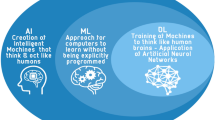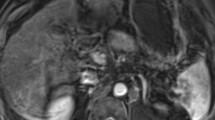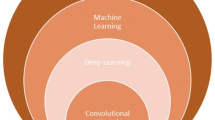Abstract
Artificial Intelligence (AI) continues to shape the practice of radiology, with imaging of hepatocellular carcinoma (HCC) being of no exception. This article prepared by members of the LI-RADS Treatment Response (TR LI-RADS) work group and associates, presents recent trends in the utility of AI applications for the volumetric evaluation and assessment of HCC treatment response. Various topics including radiomics, prognostic imaging findings, and locoregional therapy (LRT) specific issues will be discussed in the framework of HCC treatment response classification systems with focus on the Liver Reporting and Data System treatment response algorithm (LI-RADS TRA).





Similar content being viewed by others
Change history
24 May 2021
A Correction to this paper has been published: https://doi.org/10.1007/s00261-021-03098-5
Abbreviations
- TACE:
-
Transarterial chemoembolization
- CT:
-
Computed tomography
- HCC:
-
Hepatocellular carcinoma
- GLCM:
-
Gray level co-occurrence matrix
- DEB-TACE:
-
Drug-eluting bead transarterial chemoembolization
- vRECIST:
-
Volumetric response evaluation criteria in solid tumors
- CNN:
-
Convolutional neural network
References
Kielar A, Fowler KJ, Lewis S, et al. (2018) Locoregional therapies for hepatocellular carcinoma and the new LI-RADS treatment response algorithm. Abdom Radiol (NY) 43(1):218–230. https://doi.org/10.1007/s00261-017-1281-6
Shropshire EL, Chaudhry M, Miller CM, et al. (2019) LI-RADS Treatment Response Algorithm: Performance and Diagnostic Accuracy. Radiology 292(1):226–234. https://doi.org/10.1148/radiol.2019182135
Abdel Razek AAK, El-Serougy LG, Saleh GA, Shabana W, Abd El-Wahab R (2020) Reproducibility of LI-RADS treatment response algorithm for hepatocellular carcinoma after locoregional therapy. Diagn Interv Imaging 101(9):547–553. https://doi.org/10.1016/j.diii.2020.03.008
Liew C (2018) The future of radiology augmented with Artificial Intelligence: A strategy for success. Eur J Radiol 102:152–156. https://doi.org/10.1016/j.ejrad.2018.03.019
Hardy M, Harvey H (2019) Artificial intelligence in diagnostic imaging: impact on the radiography profession. The British Journal of Radiology 93(1108):20190840. https://doi.org/10.1259/bjr.20190840
Kulkarni S, Seneviratne N, Baig MS, Khan AHA (2020) Artificial Intelligence in Medicine: Where Are We Now? Academic Radiology 27(1):62–70. https://doi.org/10.1016/j.acra.2019.10.001
Zhou LQ, Wang JY, Yu SY, et al. (2019) Artificial intelligence in medical imaging of the liver. World J Gastroenterol 25(6):672–682. https://doi.org/10.3748/wjg.v25.i6.672
Pérez MJ, Grande RG (2020) Application of artificial intelligence in the diagnosis and treatment of hepatocellular carcinoma: A review. World Journal of Gastroenterology 26(37):5617–5628
Dong Y, Zhou L, Xia W, Zhao X-Y, Zhang Q, Jian J-M, Gao X, Wang W-P (2020) Preoperative Prediction of Microvascular Invasion in Hepatocellular Carcinoma: Initial Application of a Radiomic Algorithm Based on Grayscale Ultrasound Images. Frontiers in Oncology 10 (353). https://doi.org/10.3389/fonc.2020.00353
Liu D, Liu F, Xie X, et al. (2020) Accurate prediction of responses to transarterial chemoembolization for patients with hepatocellular carcinoma by using artificial intelligence in contrast-enhanced ultrasound. Eur Radiol 30(4):2365–2376. https://doi.org/10.1007/s00330-019-06553-6
Akai H, Yasaka K, Kunimatsu A, et al. (2018) Predicting prognosis of resected hepatocellular carcinoma by radiomics analysis with random survival forest. Diagn Interv Imaging 99(10):643–651. https://doi.org/10.1016/j.diii.2018.05.008
Do S, Song KD, Chung JW (2020) Basics of Deep Learning: A Radiologist’s Guide to Understanding Published Radiology Articles on Deep Learning. Korean J Radiol 21(1):33–41. https://doi.org/10.3348/kjr.2019.0312
Nakaura T, Higaki T, Awai K, Ikeda O, Yamashita Y (2020) A primer for understanding radiology articles about machine learning and deep learning. Diagn Interv Imaging 101(12):765–770. https://doi.org/10.1016/j.diii.2020.10.001
Ibrahim SM, Nikolaidis P, Miller FH, et al. (2009) Radiologic findings following Y90 radioembolization for primary liver malignancies. Abdom Imaging 34(5):566–581. https://doi.org/10.1007/s00261-008-9454-y
Joo I, Kim HC, Kim GM, Paeng JC (2018) Imaging Evaluation Following (90)Y Radioembolization of Liver Tumors: What Radiologists Should Know. Korean J Radiol 19(2):209–222. https://doi.org/10.3348/kjr.2018.19.2.209
Riaz A, Kulik L, Lewandowski RJ, et al. (2009) Radiologic-pathologic correlation of hepatocellular carcinoma treated with internal radiation using yttrium-90 microspheres. Hepatology 49(4):1185–1193. https://doi.org/10.1002/hep.22747
Abajian A, Murali N, Savic LJ, et al. (2018) Predicting Treatment Response to Intra-arterial Therapies for Hepatocellular Carcinoma with the Use of Supervised Machine Learning-An Artificial Intelligence Concept. J Vasc Interv Radiol 29(6):850–857.e851. https://doi.org/10.1016/j.jvir.2018.01.769
Morshid A, Elsayes KM, Khalaf AM, Elmohr MM, Yu J, Kaseb AO, Hassan M, Mahvash A, Wang Z, Hazle JD, Fuentes D (2019) A machine learning model to predict hepatocellular carcinoma response to transcatheter arterial chemoembolization. Radiol Artif Intell 1 (5). https://doi.org/10.1148/ryai.2019180021
Peng J, Kang S, Ning Z, et al. (2020) Residual convolutional neural network for predicting response of transarterial chemoembolization in hepatocellular carcinoma from CT imaging. Eur Radiol 30(1):413–424. https://doi.org/10.1007/s00330-019-06318-1
Wu CF, Wu YJ, Liang PC, et al. (2017) Disease-free survival assessment by artificial neural networks for hepatocellular carcinoma patients after radiofrequency ablation. J Formos Med Assoc 116(10):765–773. https://doi.org/10.1016/j.jfma.2016.12.006
Yu SJ, Kim H, Min H, et al. (2017) Targeted Proteomics Predicts a Sustained Complete-Response after Transarterial Chemoembolization and Clinical Outcomes in Patients with Hepatocellular Carcinoma: A Prospective Cohort Study. J Proteome Res 16(3):1239–1248. https://doi.org/10.1021/acs.jproteome.6b00833
Sohn JH, Duran R, Zhao Y, et al. (2017) Validation of the Hong Kong Liver Cancer Staging System in Determining Prognosis of the North American Patients Following Intra-arterial Therapy. Clin Gastroenterol Hepatol 15(5):746–755.e744. https://doi.org/10.1016/j.cgh.2016.10.036
Yau T, Tang VY, Yao TJ, et al. (2014) Development of Hong Kong Liver Cancer staging system with treatment stratification for patients with hepatocellular carcinoma. Gastroenterology 146(7):1691–1700.e1693. https://doi.org/10.1053/j.gastro.2014.02.032
Longo L, Rodrigues de Freitas LB, Santos D, Grivicich I, Alvares-da-Silva MR (2019) BCLC-B Subclassification and the Hong Kong Liver Cancer System in Intermediate Hepatocellular Carcinoma: Identifying Candidates for Curative Therapy. Am J Clin Oncol 42(5):466–471. https://doi.org/10.1097/coc.0000000000000539
Lambin P, Rios-Velazquez E, Leijenaar R, et al. (2012) Radiomics: extracting more information from medical images using advanced feature analysis. Eur J Cancer 48(4):441–446. https://doi.org/10.1016/j.ejca.2011.11.036
AI Challenge. (2019). https://www.rsna.org/en/education/ai-resources-and-training/ai-image-challenge. Accessed November 3, 2020
Bilic P, Christ P, Vorontsov E, Chlebus G, Chen H, Dou Q, Fu C-W, Han X, Heng P, Hesser J, Kadoury S, Konopczynski TK, Le M, Li C, Li X, Lipková J, Lowengrub J, Meine H, Moltz J, Pal C, Piraud M, Qi X, Qi J, Rempfler M, Roth K, Schenk A, Sekuboyina A, Zhou P, Hülsemeyer C, Beetz M, Ettlinger F, Grün F, Kaissis G, Lohöfer F, Braren R, Holch J, Hofmann F, Sommer W, Heinemann V, Jacobs C, Mamani G, Ginneken B, Chartrand G, Tang A, Drozdzal M, Ben-Cohen A, Klang E, Amitai M, Konen E, Greenspan H, Moreau J, Hostettler A, Soler L, Vivanti R, Szeskin A, Lev-Cohain N, Sosna J, Joskowicz L, Menze B (2019) The Liver Tumor Segmentation Benchmark (LiTS). ArXiv abs/1901.04056
Grewal M, Srivastava MM, Kumar P, Varadarajan S (2018) RADnet: Radiologist level accuracy using deep learning for hemorrhage detection in CT scans. 2018 IEEE 15th International Symposium on Biomedical Imaging (ISBI 2018):281-284
Ding Y, Sohn JH, Kawczynski MG, et al. (2019) A Deep Learning Model to Predict a Diagnosis of Alzheimer Disease by Using (18)F-FDG PET of the Brain. Radiology 290(2):456–464. https://doi.org/10.1148/radiol.2018180958
Çiçek Ö, Abdulkadir A, Lienkamp S, Brox T, Ronneberger O 3D U-Net: Learning Dense Volumetric Segmentation from Sparse Annotation. In: MICCAI, 2016.
Lee K, Zung J, Li P, Jain V, Seung HS (2017) Superhuman Accuracy on the SNEMI3D Connectomics Challenge. ArXiv abs/1706.00120
Ronneberger O, Fischer P, Brox T U-Net: Convolutional Networks for Biomedical Image Segmentation. In, Cham, 2015. Medical Image Computing and Computer-Assisted Intervention – MICCAI 2015. Springer International Publishing, pp 234-241
Angermann C, Haltmeier M Random 2.5D U-net for Fully 3D Segmentation. In, Cham, 2019. Machine Learning and Medical Engineering for Cardiovascular Health and Intravascular Imaging and Computer Assisted Stenting. Springer International Publishing, pp 158-166
Meine H, Chlebus G, Ghafoorian M, Endo I, Schenk A (2018) Comparison of U-net-based Convolutional Neural Networks for Liver Segmentation in CT. ArXiv abs/1810.04017
Taha AA, Hanbury A (2015) Metrics for evaluating 3D medical image segmentation: analysis, selection, and tool. BMC Med Imaging 15:29–29. https://doi.org/10.1186/s12880-015-0068-x
Wang K, Mamidipalli A, Retson T, et al. (2019) Automated CT and MRI Liver Segmentation and Biometry Using a Generalized Convolutional Neural Network. Radiology: Artificial Intelligence 1(2): https://doi.org/10.1148/ryai.2019180022
Lu F, Wu F, Hu P, Peng Z, Kong D (2016) Automatic 3D liver location and segmentation via convolutional neural network and graph cut. International Journal of Computer Assisted Radiology and Surgery 12:171–182
Zheng Y, Ai D, Mu J, et al. (2017) Automatic liver segmentation based on appearance and context information. Biomed Eng Online 16(1):16. https://doi.org/10.1186/s12938-016-0296-5
Ibragimov B, Toesca D, Chang D, Koong A, Xing L (2017) Combining deep learning with anatomical analysis for segmentation of the portal vein for liver SBRT planning. Phys Med Biol 62(23):8943–8958. https://doi.org/10.1088/1361-6560/aa9262
Vorontsov E, Cerny M, Régnier P, et al. (2019) Deep Learning for Automated Segmentation of Liver Lesions at CT in Patients with Colorectal Cancer Liver Metastases. Radiology: Artificial Intelligence 1(2): https://doi.org/10.1148/ryai.2019180014
Christ PF, Elshaer MEA, Ettlinger F, et al. (2016) Automatic Liver and Lesion Segmentation in CT Using Cascaded Fully Convolutional Neural Networks and 3D Conditional Random Fields. In: Ourselin S, Joskowicz L, Sabuncu MR, Unal G, Wells W (eds) Medical Image Computing and Computer-Assisted Intervention – MICCAI 2016. Cham: Springer International Publishing, pp 415–423
Vivanti R, Joskowicz L, Lev-Cohain N, Ephrat A, Sosna J (2018) Patient-specific and global convolutional neural networks for robust automatic liver tumor delineation in follow-up CT studies. Med Biol Eng Comput 56(9):1699–1713. https://doi.org/10.1007/s11517-018-1803-6
Sun C, Guo S, Zhang H, et al. (2017) Automatic segmentation of liver tumors from multiphase contrast-enhanced CT images based on FCNs. Artif Intell Med 83:58–66. https://doi.org/10.1016/j.artmed.2017.03.008
Ben-Cohen A, Diamant I, Klang E, Amitai M, Greenspan H Fully Convolutional Network for Liver Segmentation and Lesions Detection. In, Cham, 2016. Deep Learning and Data Labeling for Medical Applications. Springer International Publishing, pp 77-85
Vivanti R, Szeskin A, Lev-Cohain N, Sosna J, Joskowicz L (2017) Automatic detection of new tumors and tumor burden evaluation in longitudinal liver CT scan studies. International Journal of Computer Assisted Radiology and Surgery 12:1945–1957
Vivanti R, Joskowicz L, Lev-Cohain N, Ephrat A, Sosna J (2018) Patient-specific and global convolutional neural networks for robust automatic liver tumor delineation in follow-up CT studies. Medical & Biological Engineering & Computing 56:1699–1713
Park S, Chu LC, Fishman EK, et al. (2020) Annotated normal CT data of the abdomen for deep learning: Challenges and strategies for implementation. Diagn Interv Imaging 101(1):35–44. https://doi.org/10.1016/j.diii.2019.05.008
Joskowicz L, Cohen D, Caplan N, Sosna J (2019) Inter-observer variability of manual contour delineation of structures in CT. Eur Radiol 29(3):1391–1399. https://doi.org/10.1007/s00330-018-5695-5
Xu Z, Burke RP, Lee CP, et al. (2015) Efficient multi-atlas abdominal segmentation on clinically acquired CT with SIMPLE context learning. Med Image Anal 24(1):18–27. https://doi.org/10.1016/j.media.2015.05.009
Shimizu A, Ohno R, Ikegami T, et al. (2007) Segmentation of multiple organs in non-contrast 3D abdominal CT images. International Journal of Computer Assisted Radiology and Surgery 2(3):135–142. https://doi.org/10.1007/s11548-007-0135-z
Wolz R, Chu C, Misawa K, Mori K, Rueckert D (2012) Multi-organ abdominal CT segmentation using hierarchically weighted subject-specific atlases. Med Image Comput Comput Assist Interv 15(Pt 1):10–17. https://doi.org/10.1007/978-3-642-33415-3_2
Linguraru MG, Sandberg JK, Li Z, Pura JA, Summers RM (2009) Atlas-based Automated Segmentation of Spleen and Liver using Adaptive Enhancement Estimation. Med Image Comput Comput Assist Interv 5762:1001–1008. https://doi.org/10.1007/978-3-642-04271-3_121
Zhang X, Tian J, Deng K, Wu Y, Li X (2010) Automatic liver segmentation using a statistical shape model with optimal surface detection. IEEE Trans Biomed Eng 57(10):2622–2626. https://doi.org/10.1109/tbme.2010.2056369
Wang X, Zheng Y, Gan L, et al. (2017) Liver segmentation from CT images using a sparse priori statistical shape model (SP-SSM). PLoS One 12(10): https://doi.org/10.1371/journal.pone.0185249
Spinczyk D, Krasoń A (2018) Automatic liver segmentation in computed tomography using general-purpose shape modeling methods. Biomed Eng Online 17(1):65. https://doi.org/10.1186/s12938-018-0504-6
Zheng B-H, Liu L-Z, Zhang Z-Z, et al. (2018) Radiomics score: a potential prognostic imaging feature for postoperative survival of solitary HCC patients. BMC Cancer 18(1):1148. https://doi.org/10.1186/s12885-018-5024-z
Reiner CS, Gordic S, Puippe G, et al. (2016) Histogram Analysis of CT Perfusion of Hepatocellular Carcinoma for Predicting Response to Transarterial Radioembolization: Value of Tumor Heterogeneity Assessment. Cardiovasc Intervent Radiol 39(3):400–408. https://doi.org/10.1007/s00270-015-1185-1
Fedorov A, Beichel R, Kalpathy-Cramer J, et al. (2012) 3D Slicer as an image computing platform for the Quantitative Imaging Network. Magn Reson Imaging 30(9):1323–1341. https://doi.org/10.1016/j.mri.2012.05.001
Yushkevich PA, Piven J, Hazlett HC, et al. (2006) User-guided 3D active contour segmentation of anatomical structures: significantly improved efficiency and reliability. Neuroimage 31(3):1116–1128. https://doi.org/10.1016/j.neuroimage.2006.01.015
van Griethuysen JJM, Fedorov A, Parmar C, et al. (2017) Computational Radiomics System to Decode the Radiographic Phenotype. Cancer Res 77(21):e104–e107. https://doi.org/10.1158/0008-5472.Can-17-0339
Zhang L, Fried DV, Fave XJ, et al. (2015) IBEX: an open infrastructure software platform to facilitate collaborative work in radiomics. Med Phys 42(3):1341–1353. https://doi.org/10.1118/1.4908210
Rizzo S, Botta F, Raimondi S, et al. (2018) Radiomics: the facts and the challenges of image analysis. Eur Radiol Exp 2(1):36. https://doi.org/10.1186/s41747-018-0068-z
Miranda Magalhaes Santos JM, Clemente Oliveira B, Araujo-Filho JAB, et al. (2020) State-of-the-art in radiomics of hepatocellular carcinoma: a review of basic principles, applications, and limitations. Abdom Radiol (NY) 45(2):342–353. https://doi.org/10.1007/s00261-019-02299-3
Larkin TJ, Canuto HC, Kettunen MI, et al. (2014) Analysis of image heterogeneity using 2D Minkowski functionals detects tumor responses to treatment. Magn Reson Med 71(1):402–410. https://doi.org/10.1002/mrm.24644
Hui TCH, Chuah TK, Low HM, Tan CH (2018) Predicting early recurrence of hepatocellular carcinoma with texture analysis of preoperative MRI: a radiomics study. Clin Radiol 73(12):1056.e1011–1056.e1016. https://doi.org/10.1016/j.crad.2018.07.109
Zhang Z, Jiang H, Chen J, et al. (2019) Hepatocellular carcinoma: radiomics nomogram on gadoxetic acid-enhanced MR imaging for early postoperative recurrence prediction. Cancer Imaging 19(1):22. https://doi.org/10.1186/s40644-019-0209-5
Park YK, Song SK, Kim BW, et al. (2017) Prognostic significance of microvascular invasion in tumor stage for hepatocellular carcinoma. World J Surg Oncol 15(1):225. https://doi.org/10.1186/s12957-017-1292-3
Lim KC, Chow PK, Allen JC, et al. (2011) Microvascular invasion is a better predictor of tumor recurrence and overall survival following surgical resection for hepatocellular carcinoma compared to the Milan criteria. Ann Surg 254(1):108–113. https://doi.org/10.1097/SLA.0b013e31821ad884
Ni M, Zhou X, Lv Q, et al. (2019) Radiomics models for diagnosing microvascular invasion in hepatocellular carcinoma: which model is the best model? Cancer Imaging 19(1):60. https://doi.org/10.1186/s40644-019-0249-x
He M, Zhang P, Ma X, et al. (2020) Radiomic Feature-Based Predictive Model for Microvascular Invasion in Patients With Hepatocellular Carcinoma. Front Oncol 10: https://doi.org/10.3389/fonc.2020.574228
Xu X, Zhang HL, Liu QP, et al. (2019) Radiomic analysis of contrast-enhanced CT predicts microvascular invasion and outcome in hepatocellular carcinoma. J Hepatol 70(6):1133–1144. https://doi.org/10.1016/j.jhep.2019.02.023
Banerjee S, Wang DS, Kim HJ, et al. (2015) A computed tomography radiogenomic biomarker predicts microvascular invasion and clinical outcomes in hepatocellular carcinoma. Hepatology 62(3):792–800. https://doi.org/10.1002/hep.27877
Peng J, Zhang J, Zhang Q, et al. (2018) A radiomics nomogram for preoperative prediction of microvascular invasion risk in hepatitis B virus-related hepatocellular carcinoma. Diagn Interv Radiol 24(3):121–127. https://doi.org/10.5152/dir.2018.17467
Soltaninejad M, Yang G, Lambrou T, et al. (2017) Automated brain tumour detection and segmentation using superpixel-based extremely randomized trees in FLAIR MRI. Int J Comput Assist Radiol Surg 12(2):183–203. https://doi.org/10.1007/s11548-016-1483-3
van Heeswijk MM, Lambregts DM, van Griethuysen JJ, et al. (2016) Automated and Semiautomated Segmentation of Rectal Tumor Volumes on Diffusion-Weighted MRI: Can It Replace Manual Volumetry? Int J Radiat Oncol Biol Phys 94(4):824–831. https://doi.org/10.1016/j.ijrobp.2015.12.017
Odland A, Server A, Saxhaug C, et al. (2015) Volumetric glioma quantification: comparison of manual and semi-automatic tumor segmentation for the quantification of tumor growth. Acta Radiol 56(11):1396–1403. https://doi.org/10.1177/0284185114554822
Hopper KD, Kasales CJ, Van Slyke MA, et al. (1996) Analysis of interobserver and intraobserver variability in CT tumor measurements. American Journal of Roentgenology 167(4):851–854. https://doi.org/10.2214/ajr.167.4.8819370
Sohaib SA, Turner B, Hanson JA, et al. (2000) CT assessment of tumour response to treatment: comparison of linear, cross-sectional and volumetric measures of tumour size. Br J Radiol 73(875):1178–1184. https://doi.org/10.1259/bjr.73.875.11144795
Zhou Z, Xue-chang Z, Si-ming Z, Hua-fei X, Yue-ding S (2018) Semi-automatic Liver Segmentation in CT Images Through Intensity Separation and Region Growing. Procedia Computer Science 131:220–225. https://doi.org/10.1016/j.procs.2018.04.206
Ma J, Li Y, Wu Y, Zhang M, He J, Qiu Y, Yang X Automatic Liver Tumor Segmentation Based on Random Forest and Fuzzy Clustering. In, Cham, 2019. The Proceedings of the International Conference on Sensing and Imaging. Springer International Publishing, pp 403-410
Yu Q, Shi Y, Sun J, et al. (2019) Crossbar-Net: A Novel Convolutional Neural Network for Kidney Tumor Segmentation in CT Images. IEEE Transactions on Image Processing 28(8):4060–4074. https://doi.org/10.1109/TIP.2019.2905537
Li X, Chen H, Qi X, et al. (2018) H-DenseUNet: Hybrid Densely Connected UNet for Liver and Tumor Segmentation From CT Volumes. IEEE Trans Med Imaging 37(12):2663–2674. https://doi.org/10.1109/tmi.2018.2845918
Tacher V, Lin M, Duran R, et al. (2016) Comparison of Existing Response Criteria in Patients with Hepatocellular Carcinoma Treated with Transarterial Chemoembolization Using a 3D Quantitative Approach. Radiology 278(1):275–284. https://doi.org/10.1148/radiol.2015142951
Moawad A, Fuentes D, Khalaf A, et al. (2020) Feasibility of Automated Volumetric Assessment of Large Hepatocellular Carcinomas’ Responses to Transarterial Chemoembolization. Frontiers in Oncology 10:572. https://doi.org/10.3389/fonc.2020.00572
Acknowledgements
We are grateful to the members of the LI-RADS Treatment Response (TR LI-RADS) work group for their guidance and helpful discussions.
Funding
None.
Author information
Authors and Affiliations
Contributions
BS and CS analyzed the data and wrote the manuscript; AM, MGA, MB, RKG, VY, RR, MG, and JY made critical revisions related to important intellectual content of the manuscript; CS, AM, and KE analyzed the literature, wrote the manuscript and made critical revisions related to important intellectual content of the manuscript; and all authors have read and approve the final manuscript
Corresponding author
Ethics declarations
Conflict of interests
The authors declare that they have no conflict of interest.
Additional information
Publisher's Note
Springer Nature remains neutral with regard to jurisdictional claims in published maps and institutional affiliations.
Rights and permissions
About this article
Cite this article
Spieler, B., Sabottke, C., Moawad, A.W. et al. Artificial intelligence in assessment of hepatocellular carcinoma treatment response. Abdom Radiol 46, 3660–3671 (2021). https://doi.org/10.1007/s00261-021-03056-1
Received:
Revised:
Accepted:
Published:
Issue Date:
DOI: https://doi.org/10.1007/s00261-021-03056-1




